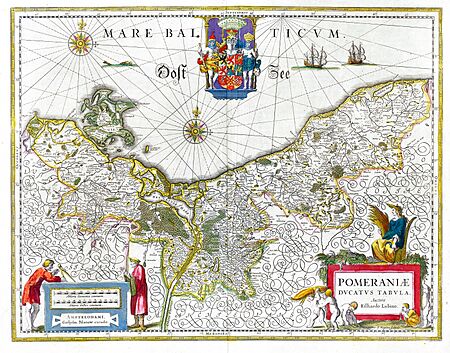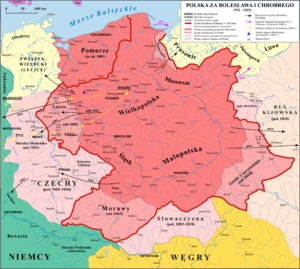Bruno of Querfurt facts for kids
Quick facts for kids SaintBruno of Querfurt, O.S.B. Cam. |
|
|---|---|
| Bishop and Martyr; Second Apostle of the Prussians | |
| Born | c. 974 Querfurt, Holy Roman Empire (now in Saxony-Anhalt) |
| Died | 14 February 1009 Kievan Rus |
| Venerated in | Eastern Orthodox Church Roman Catholic Church (Camaldolese Order) |
| Feast | 15 October |
Bruno of Querfurt (born around 974 – died February 14 or March 9/14, 1009) was a Christian missionary and monk. He was also a martyr, meaning he died for his beliefs. Bruno was killed near the border of Kievan Rus and Lithuania because he was trying to share Christianity. People sometimes call him the second "Apostle of the Prussians" because he worked to spread the Christian faith among them.
Contents
The Story of Saint Bruno
Bruno's Early Life
Bruno was born into an important family in Querfurt, a place that is now in Saxony-Anhalt, Germany. Some people say he was related to the Holy Roman Emperor Otto III.
When Bruno was six years old, he went to school at the Magdeburg Cathedral. This was a famous school led by Adalbert of Magdeburg. Later, when he was still young, Bruno became a canon at the Magdeburg Cathedral. This meant he was a special priest who helped with the church's daily duties.
In 995, Emperor Otto III made Bruno his court chaplain. This was an important job where Bruno helped the Emperor with religious matters.
A Monk's Calling
While in Rome, Bruno met Adalbert of Prague. Adalbert was known as the first "Apostle of the Prussians." He was killed a year later for his missionary work. Meeting Adalbert inspired Bruno greatly.
In 998, Bruno decided to become a monk. He joined a Benedictine monastery near Ravenna. There, he trained under a strict teacher named Romuald. Bruno spent a lot of time at this monastery. He even wrote a book about the life of Adalbert of Prague.
Becoming a Missionary
Emperor Otto III wanted to build a monastery between the Elbe and Oder rivers. This monastery would help spread Christianity to the local people. In 1001, two monks from Bruno's monastery traveled to Poland to learn the language. Bruno stayed in Italy, waiting for Pope Sylvester II to give him a special mission.
In 1003, Pope Sylvester II chose Bruno, who was 33 years old, to lead a mission. His goal was to share Christianity with people in Eastern Europe who were not yet Christian. Bruno left Rome in 1004. He was made an archbishop by Archbishop Tagino of Magdeburg.
Because of a conflict between Emperor Henry II and Duke Boleslaus I of Poland, Bruno could not go directly to Poland. Instead, he traveled to Hungary. There, he visited places where Adalbert of Prague had worked.
Bruno tried to convince Ahtum, a duke in Hungary, to follow the Bishop of Rome (the Pope). This caused a big disagreement with local monks. Bruno decided to leave the area peacefully. Before he left, he finished his book, "Life of Adalbert of Prague." This book told the story of how the Hungarians had recently become Christian.
Journeys and Missions
After his time in Hungary, Bruno went to Kyiv. The ruler there, Grand Duke Vladimir I, allowed Bruno to teach Christianity to the Pechenegs. These were nomadic people living between the Danube and Don rivers. Bruno stayed for five months and baptized about thirty adults. He also helped create a peace treaty between the Pechenegs and Kyiv.
Before going to Poland, Bruno chose a bishop for the Pechenegs. While in Poland, he also chose the first Bishop of Sweden. It is said that Bruno sent people to baptize the king of Sweden. Bruno also learned that his friend Benedict and four other monks had been killed by robbers in 1003. Bruno gathered stories from people who saw what happened and wrote a sad history about these "Five Martyred Brothers."
His Final Mission and Legacy
In late 1008, Bruno and eighteen friends went on a mission to the Old Prussians. They successfully converted a leader named Netimer. Then, they traveled east, likely towards Yotvingia.
Bruno faced strong opposition as he tried to spread his message in this border area. He ignored warnings and continued his work. On February 14 (or March 9 or 14) in 1009, Bruno was killed. Most of his eighteen companions were also killed by Zebeden, who was Netimer's brother. Many old writings from the 11th to 15th centuries tell this story.
Soon after his death, people began to honor Bruno and his companions as martyrs. Bruno was quickly made a saint. Some people believe that the town of Braunsberg was named after Bruno.
See also
- Name of Lithuania
- Christianization of Lithuania



